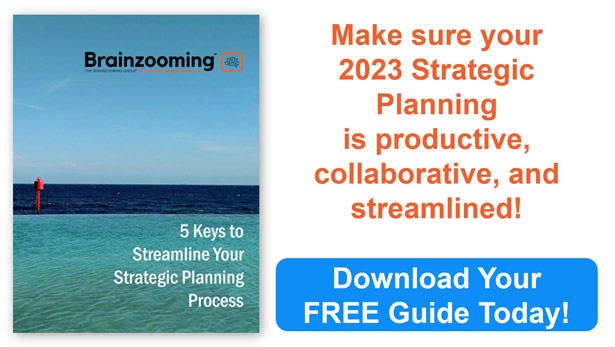November 10 is the anniversary of the Brainzooming blog's launch, introducing our strategic thinking manifesto, which originally appeared as the initial Brainzooming blog articles. At its core, the manifesto shares four keys to cultivating successful strategic thinking within organizations.
The Brainzooming strategic thinking manifesto is the foundation of our business philosophy and how we are creating strategic impact for clients. Yet when it was published at the blog’s launch, there was no other Brainzooming content online to which we could link key concepts.
Now, years into writing articles on the Brainzooming method applied to strategy, creativity, innovation, and social media, there is ample supporting content covering the four keys to cultivating successful strategic thinking in any organization:
- Simply Defining Strategic Thinking
- Awakening Strategic Thinking
- Introducing Impactful Strategic Thinking Tools
- Turning Strategic Thinking into Impact
4 Keys to Cultivating Strategic Thinking
 Preparing our original presentation on cultivating strategic thinking, current literature suggested a significant gap between senior management expectations and the impact from strategic thinking. Senior leaders have strong expectations about their employees' abilities to think strategically and how much time their senior teams should spend on strategic issues. One survey reported senior leaders expected to spend 1/3 of their time on strategic issues. Another survey found though that senior teams self-report spending less than 1 hour per month, if any time at all, on strategic issues.
Preparing our original presentation on cultivating strategic thinking, current literature suggested a significant gap between senior management expectations and the impact from strategic thinking. Senior leaders have strong expectations about their employees' abilities to think strategically and how much time their senior teams should spend on strategic issues. One survey reported senior leaders expected to spend 1/3 of their time on strategic issues. Another survey found though that senior teams self-report spending less than 1 hour per month, if any time at all, on strategic issues.
Why the discrepancy?
We repeatedly see one or more of these reasons present in organizations struggling with strategic impact:
- Something is missing - Too often typical stereotypes about strategic planning don't lend themselves to people wanting to invest time in the activity.
- Somebody is missing - Strategic thinking is frequently seen narrowly as the sole responsibility of senior management. This belief cuts off the diversity of external & internal perspectives needed for effective strategic thinking.
- Outcomes are missing - Strategic sessions, at best, often result in what participants label as "interesting conversations." Interesting conversations, however, rarely translate into clear outcomes creating strategic impact for an organization.
Through meaningfully changing strategic thinking perspectives, it's possible to address each of these gaps, and involve many individuals throughout an organization into clearly beneficial strategic thinking roles with great results.
1. Simply Defining Strategic Thinking
One reason strategic thinking doesn’t take place is there isn’t a clear understanding of what strategic thinking is. As a result, ill-fated attempts to be “strategic” fall short, creating a reluctance to broadly address strategy.
The Brainzooming Group starts with a simple definition for strategic thinking: Addressing Things that Matter with Insight & Innovation.
There are three important elements in the definition to shape productive strategic thinking and invite greater participation and results.
- Understand the Overall Business & Direction – What’s important to the business and its customers – past, present, & future? There are various questions whose answers identify this, but one of the best is, “What are we trying to achieve?” You can always return to this question to re-set a discussion stuck in the weeds.
- Recognize there are Multiple Strategic Viewpoints - What’s strategic differs on whether your view is company-wide, departmental, functional, or personal. While the strategic views within an organization should be interconnected, what's strategic will differ between senior management and a specific department. Because of this, it's vital to clearly identify which view your strategic thinking is addressing.
- Take “Time” Out of Your Definition of Strategic – Strategic issues can take place this afternoon just as easily as in the future; just because something won't come to pass for years doesn’t necessarily make it strategic. If you don’t realize this, you’ll never address strategic discussions because pressing issues (which may be hugely strategic) are viewed as tactics requiring immediate solutions - and thinking seems to slow things down, thwarting progress.
- Use Strategic Thinking Exercises Intended to Creatively Tackle Challenging Issues - Using strategic thinking exercises helps neutralize traditional (potentially biased) perspectives, reducing unproductive politics and blind spots stifling creating strategic impact.
“Insight” - Strategic thinking starts with relevant insights gained from inside and outside the organization. Combining and analyzing diverse information allows you to identify relationships leading to creating strategic impact. You can start by assessing your strategic position in new and different ways through robust strategic thinking exercises.
“Innovation” - One of the best approaches to anticipate future relevant events is considering multiple perspectives and exploring a full range of possibilities that may develop. Simple question-based exercises foster a more innovative look at the business.
2. Awakening Strategic Thinking
If senior managers are the only ones sanctioned to think strategically in an organization, there is a real problem. A company’s senior team tends to view the world in a relatively homogenous manner – from having shared experiences to holding a common perspective on the company and the market. Shaking up that sameness and familiarity is vital.
Great strategic thinking springs from diverse perspectives, cultivated and managed toward a view of the current & future business environment that increases the likelihood of creating strategic impact. Achieving this means spreading strategic thinking responsibility throughout the business.
Here are some fundamentals for accomplishing this:
Keep track of who is thinking and how they think – In bringing people together for strategic thinking, make sure three vital perspectives are represented with people that have:
- Solid, front-line business experience (to help frame business issues)
- Broad functional knowledge (with an understanding of capabilities)
- Creative energy (acting as catalysts to view things in new & unconventional ways)
Invest time in productive thinking – Create and protect time for strategic thinking. This requires a willingness to invest dedicated time to consider many possibilities, to narrow focus to the best ones, and then develop & implement the best strategies. Focused time helps create an environment where people can selectively turn off conventional wisdom, triggering many more possibilities.
Use structure to increase output and efficiency – In initial phases, brainstorming techniques help productively manage how people with varied perspectives can increase the number of ideas generated very efficiently. Some starting principles include:
- Have people share what comes to mind right away, not censoring themselves or others.
- Use short, intense brainstorming sessions – spend minutes, not hours, considering an issue from multiple perspectives.
- Emphasize the quantity of ideas over the initial perceived quality or practicality. Set a demanding goal – typically look for 4 or 7 ideas per minute when brainstorming.
- Say all ideas aloud and write them down on sticky notes with markers; this makes it easier to select, combine, & prioritize ideas in later stages.
3. Introducing Impactful Strategic Thinking Tools
A challenge with standard strategic planning approaches is people are familiar with standard strategic planning questions and answers. Additionally, if people are entering strategic planning with long histories inside an organization, they know the expected answers to standard strategic planning questions.
Aligned with typical areas addressed during strategic planning, here are some of the alternative paths The Brainzooming Group uses to reach vital insights leading to creating strategic impact.
 Strengths, Weaknesses, Opportunities, and Threats
Strengths, Weaknesses, Opportunities, and Threats
- Strategic Connections – 3 Tips for Identifying More Opportunities
- Reinvent Yourself Week – Look and Ask Around
- Brand Value – A Simple Way to Identify Your Brand Benefits
- A Spoonful of Unconventional Makes the Conventionalism Go Down
- 3 Strategic Thinking Exercises to Spot Emerging Competitors
- 11 Strategic Questions for Disruptive Innovation in Markets
- We’ve Seen the Enemy & They Don’t Look Anything Like Us
Vital Trends and Innovative Directions
- Incorporating the Expertise of Lead Users
- New, Innovative Ideas – Strategy Planning with What’s It Like
Setting Priorities
4. Turning Strategic Thinking into Impact
Strategic thinking often falls short because specific outcomes are difficult to trace to original strategic thinking or planning effort.
Beyond approaches covered previously to focus strategic thinking, broaden participation, and increase its rigor, a several principles can help create more tangible outcomes.
 Be prepared with a rigorous prioritization approach – Frequently, 5 to 15% of the possibilities from a strategic thinking session have near-term development potential or strong relevance. A great first pass prioritization approach is to approximate the number of ideas your team has generated and divide it by 5 to arrive at 20% of the ideas. Divide this total by the number of participants; the result represents how many ideas each person will be able to select based on their belief in an idea’s strength and/or potential.
Be prepared with a rigorous prioritization approach – Frequently, 5 to 15% of the possibilities from a strategic thinking session have near-term development potential or strong relevance. A great first pass prioritization approach is to approximate the number of ideas your team has generated and divide it by 5 to arrive at 20% of the ideas. Divide this total by the number of participants; the result represents how many ideas each person will be able to select based on their belief in an idea’s strength and/or potential.
Let participants start narrowing – With their individual idea “allowances” set, participants can begin selecting ideas that they’ll take through the prioritization process. Ideas chosen can be their own or those of others. The important thing is that participants believe in the ideas they select.
After each team member selects ideas, have them make an initial assessment of each idea using the following questions – What are the idea’s strengths? What are the idea’s weaknesses? What’s unexpected or unusual about the idea relative to the status quo? What’s your initial recommendation about how the idea could be addressed? It’s beneficial to share these initial thoughts aloud to familiarize group members with previously overlooked ideas.
Perform individual ranking with group input – Following the initial report-out, use a 4-box grid to allow individuals to place their ideas relative to two dimensions:
- Potential Impact – On a scale from Minimal to Dramatic
- Implementation Ease – On a scale from Easy to Difficult
 Once individuals have placed ideas on the grid, talk through each one to see what support or challenges exist within the group. Typically, team members will overstate the number of easy to implement ideas expected to have dramatic impact. If true, these ideas are very attractive, but often they’ll have less impact or may be more difficult to implement than originally suspected.
Once individuals have placed ideas on the grid, talk through each one to see what support or challenges exist within the group. Typically, team members will overstate the number of easy to implement ideas expected to have dramatic impact. If true, these ideas are very attractive, but often they’ll have less impact or may be more difficult to implement than originally suspected.
Don’t be afraid to consider moving an idea if there’s a clear view from the group that it’s stronger or weaker than its original placement. The result of this combined individual-group exercise should be a much more refined set of ideas, with a good deal of input to set the stage for selecting a few ideas that will be pursued further for development.
Keep track of what’s left over – It pays to track ideas that aren’t selected initially. These often resurface later and it’s nice to be able to tie them back to the strategic thinking efforts that you’ve been conducting.
From Strategic Thinking to Creating Strategic Impact
Ideally you are better prepared to cultivate strategic thinking as a precursor to creating strategic impact in your department or business. Subscribe to the Brainzooming blog, seek ongoing learning, and schedule time soon for fruitful strategic thinking! And if you need help to start or deliver results, let us know. We'd love to help you in creating strategic impact. – Mike Brown
If you enjoyed this article, subscribe to the free Brainzooming email updates.
The Brainzooming Group helps make smart organizations more successful by rapidly expanding their strategic options and creating innovative plans they can efficiently implement. Email us at info@brainzooming.com or call us at 816-509-5320 to learn how we can help you enhance your strategy and implementation efforts.




